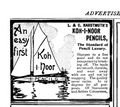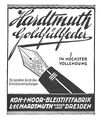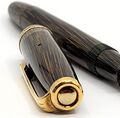Differenze tra le versioni di "Hardtmuth/en"
(Creata pagina con "Available material: {{GenerateSmallBrandGallery|Hardtmudt}} <noinclude> {{BrandData|Founder=Joseph Hardtmudt|Date=1790|ProdDate=1990|Place=Vienna|Country=AT}}") |
|||
| (14 versioni intermedie di 2 utenti non mostrate) | |||
| Riga 1: | Riga 1: | ||
| − | <noinclude></noinclude>''Hardtmuth'' (or ''"L & C Hardtmuth"''), more commonly known as ''"[[Koh-i-Noor]] Hardtmudt"'', is a historic producer of pencils and office supplies that was founded in [[1790]] by ''Joseph Hardtmudt'', which in [[1802]] patented | + | <noinclude></noinclude>''Hardtmuth'' (or ''"L & C Hardtmuth"''), more commonly known as ''"[[Koh-i-Noor]] Hardtmudt"'', is a historic producer of pencils and office supplies that was founded in [[1790]] by ''Joseph Hardtmudt'' in Vienna as an earthenware factory, which in [[1802]] patented a pencil made of clay and coal.<ref>although the successors of the American subsidiary proclaim on [https://www.kohinoorusa.com/about their site] inventors of the first graphite mine, the record belongs to [[Conté]] with a patent dated [[1785]].</ref> Established in the Austro-Hungarian Empire, in [[1848]] the factory was transferred by the sons of the founder from Vienna to České Budějovice, currently in the Czech Republic. The company introduced in [[1889]] the line of pencils ''"Koh-i-Noor"'', called by the same name of the famous diamond to magnify their quality. To distinguish them, they were painted in yellow, a color that from then has become a classic for pencils. |
| − | The ''Koh-i-Noor'' brand became the hallmark of the company, that with [[Faber Castell]] was one of the leading European pencils producers and is still on the market in the field of stationery and drawing tools. | + | The ''Koh-i-Noor'' brand became the hallmark of the company, that with [[Faber Castell]] was one of the leading European pencils producers and is still on the market in the field of stationery and drawing tools. In [[1919]] the American branch was opened in Bloomsbury, New Jersey, and in [[1931]] factories in Poland and Romania were opened in cooperation with the then [[Johan Faber A. G.|Johann Faber]].<ref>according to [https://collection.sciencemuseumgroup.org.uk/people/cp118887/l-c-hardtmuth this reference].</ref>After World War II the factories in the eastern countries (Poland, Romania and Czechoslovakia) were nationalized, while the American subsidiary separated from the parent company, becoming ''"Koh-i-noor USA"''. Only the Austrian company retained its original ownership. In [[1957]] the [[Rotring|Riepe Works]] ceded to the ''"Koh-i-noor USA"'' the rights to the {{Cite patent|US|3020884}} of the ''"Rapidograph"''. To date, the European rights for the ''"L. & C. Hardtmuth"'' and ''"Koh-I-Noor"'' trademarks are held by ''"Crayomine"'', founded in [[1960]] in Vaduz. |
| + | |||
| + | The company's activities in the fountain pen market derive mainly from the marketing of pens produced by others; in particular it marketed [[Waterman]] throughout Europe, for which they were the official agent until World War I. But sometimes there was also a marketing of own-brand fountain pens. Not many details are known about the company's own productions, although there are some advertisements around the 1930s that show own-branded ones but about which very little is known, and there is evidence of relations with the [[Union Vulpenhouderfabriek]] in the 1950s.<ref>like the one illustrated in [https://forum.fountainpen.it/viewtopic.php?t=32006 this presentation] on the Italian forum.</ref> | ||
Refererences: | Refererences: | ||
| − | [http://pencils.wikia.com/wiki/L%26C_Hardtmuth], [http://en.wikipedia.org/wiki/Koh-i-Noor_Hardtmuth], [http://it.wikipedia.org/wiki/Koh-I-Noor_Hardtmuth] | + | [http://pencils.wikia.com/wiki/L%26C_Hardtmuth], [http://en.wikipedia.org/wiki/Koh-i-Noor_Hardtmuth], [http://it.wikipedia.org/wiki/Koh-I-Noor_Hardtmuth], [https://www.kohinoorusa.com/about], [https://collection.sciencemuseumgroup.org.uk/people/cp118887/l-c-hardtmuth], [https://forum.fountainpen.it/viewtopic.php?t=32043] |
| − | Available material: {{GenerateSmallBrandGallery| | + | Available material: {{GenerateSmallBrandGallery|Hardtmuth}} |
| − | <noinclude> | + | <noinclude>==Notes== |
| + | <references/> | ||
{{BrandData|Founder=Joseph Hardtmudt|Date=1790|ProdDate=1990|Place=Vienna|Country=AT}} | {{BrandData|Founder=Joseph Hardtmudt|Date=1790|ProdDate=1990|Place=Vienna|Country=AT}} | ||
{{CategorizeBrand|Austria|Small brand}}</noinclude> | {{CategorizeBrand|Austria|Small brand}}</noinclude> | ||
Versione attuale delle 11:11, 15 feb 2024
Hardtmuth (or "L & C Hardtmuth"), more commonly known as "Koh-i-Noor Hardtmudt", is a historic producer of pencils and office supplies that was founded in 1790 by Joseph Hardtmudt in Vienna as an earthenware factory, which in 1802 patented a pencil made of clay and coal.[1] Established in the Austro-Hungarian Empire, in 1848 the factory was transferred by the sons of the founder from Vienna to České Budějovice, currently in the Czech Republic. The company introduced in 1889 the line of pencils "Koh-i-Noor", called by the same name of the famous diamond to magnify their quality. To distinguish them, they were painted in yellow, a color that from then has become a classic for pencils.
The Koh-i-Noor brand became the hallmark of the company, that with Faber Castell was one of the leading European pencils producers and is still on the market in the field of stationery and drawing tools. In 1919 the American branch was opened in Bloomsbury, New Jersey, and in 1931 factories in Poland and Romania were opened in cooperation with the then Johann Faber.[2]After World War II the factories in the eastern countries (Poland, Romania and Czechoslovakia) were nationalized, while the American subsidiary separated from the parent company, becoming "Koh-i-noor USA". Only the Austrian company retained its original ownership. In 1957 the Riepe Works ceded to the "Koh-i-noor USA" the rights to the nº US-3020884 of the "Rapidograph". To date, the European rights for the "L. & C. Hardtmuth" and "Koh-I-Noor" trademarks are held by "Crayomine", founded in 1960 in Vaduz.
The company's activities in the fountain pen market derive mainly from the marketing of pens produced by others; in particular it marketed Waterman throughout Europe, for which they were the official agent until World War I. But sometimes there was also a marketing of own-brand fountain pens. Not many details are known about the company's own productions, although there are some advertisements around the 1930s that show own-branded ones but about which very little is known, and there is evidence of relations with the Union Vulpenhouderfabriek in the 1950s.[3]
Refererences: [1], [2], [3], [4], [5], [6]
Available material:
Notes
- ↑ although the successors of the American subsidiary proclaim on their site inventors of the first graphite mine, the record belongs to Conté with a patent dated 1785.
- ↑ according to this reference.
- ↑ like the one illustrated in this presentation on the Italian forum.





































